Lecture 9A: Sedimentary Rocks and Processes
Sedimentary Rocks
A rock is classified as a sedimentary rock if:
It is composed of sediments — either detrital (rock and mineral fragments) or biochemical / bioclastic (shells and plant material) — that undergo lithification by compaction and cementation; or
It is composed of minerals that form in situ by precipitation from a solution (chemical) and accumulate and bind into a chemical sedimentary rock.
Clastic - composed of detrital sediments
Silt and Clay
Mudstone / Siltstone- made of clay-sized particles if they don’t break into planes
Shale - if they break into planes
Sand
Sandstone - composed of sand (fine, medium, coarse, very coarse) and exhibits lamination or beddings
Granule, Pebble, Cobble, and Boulder
Conglomerate - has round clasts
Breccia - has highly angular clasts
Biochemical - composed of biologically-derived sediments
Coquina - predominantly made of shells
Fossiliferous limestone - mostly made of limestone with a lot of fossils (shells and crinoid)
Chert - made of radiolarians and is found in deep marine environment, dominate below the CCD or the carbonate compensation depth
Diatomites - made of diatoms which can be pennate or centric
Chalk - made of coccolithophores

Chemical - precipitated from solution from mineral-rich water
Speleothems - cave precipitates
The water that drips on caves is mineral-rich, so they precipitate stalactites in the ceiling and stalagmites on the floor and when they connect, it is called a column
Travertine - made of terrestrial limestone, precipitate not from the coast or not from the ocean but from terrestrial water
Sedimentary Processes
Refers to all processes that shape a sedimentary rock — from sediment source to its formation and modification
Sedimentary Cycle
Source area
Weathering
Erosion
Transport
Deposition
Diagenesis
Lithification (compaction and cementation)
Modification (rextallization and replacement, dissolution, bioturbation)
Sedimentary Rocks
Sedimentary Cycle
Weathering
Involves the in-situ physical, chemical, or biogenic breakdown of rock material into smaller fragments
Fragments may be: mineral or rock fragment or dissolved ions
Types of weathering:
Physical Weathering
Disintegration
Chemical Weathering
Decomposition
Differential weathering
different rock materials weather at different rates
wherein less resistant rocks are weathered and eroded more easily
Example: Bouma sequence
Physical Weathering
Dominant in dry and cold environments
Arid environments (little to no moisture)
Disintegration
the process of physical weathering: the breakdown of larger and more coherent rock bodies into smaller units. May be due to mechanical or biological processes:
Unloading
fracturing and jointing in response to decrease in the lithostatic pressure. Decrease in lithostatic pressure results to the erosion and/or faulting of overburden rocks
Exfoliation - Spalling off slabs as weathering continues, creating onion-like layers. Material is shed superficially as slabs or scales
Frost Action/Shattering
pre-existing fractures and weak surfaces are enlarged by the expansion of water
Frost Wedging - Occurs due to stresses induced by the expansion of ice when water trapped in existing joints and fractures freezes. Forms talus (debris in the foot of slopes) deposits downslope of bare rock surfaces
Crystal Growth
expansive force from the growth of crystals weaken the rocks and enlarge cracks. Common in evaporites
Abrasion
mechanical wearing down, scraping, or grinding away of a rock surface by friction. Results from the action of running water, wind, or ice. Entrained particles enhance the effect abrasion, especially in the case of wind (sandblasting)
Sandblasting - occurs when wind blow sand or silt against rocks
Glacial striations - very polished area with a lot of scratch marks
Pebbles in beaches
Ventifacts - natural rock formation from sandblasting when wind that blows on the rock sculps the surface
Slaking
wetting and drying of rocks that contain micas and clays (minute minerals that expands when wet) that expand when wet, generating stress to adjacent minerals. Common in clay-bearing rocks and soils
Insolation
volume changes from temperature change that induce stresses that spall (peel-off) small particles from the rock body
Repeated expansion and contraction due to rapid T changes
Common in clay-bearing rocks and soils

Evorsion
kinetic energy of flowing water alone, without suspended sediments, may be enough to erode rocks and sediments in a stream bed (evorsion), as in waterfall pools, although the effect is enhanced by abrasion.
Cavitation
breaking of rocks by ocean waves from bubble implosion
creates sea caves and sea arches
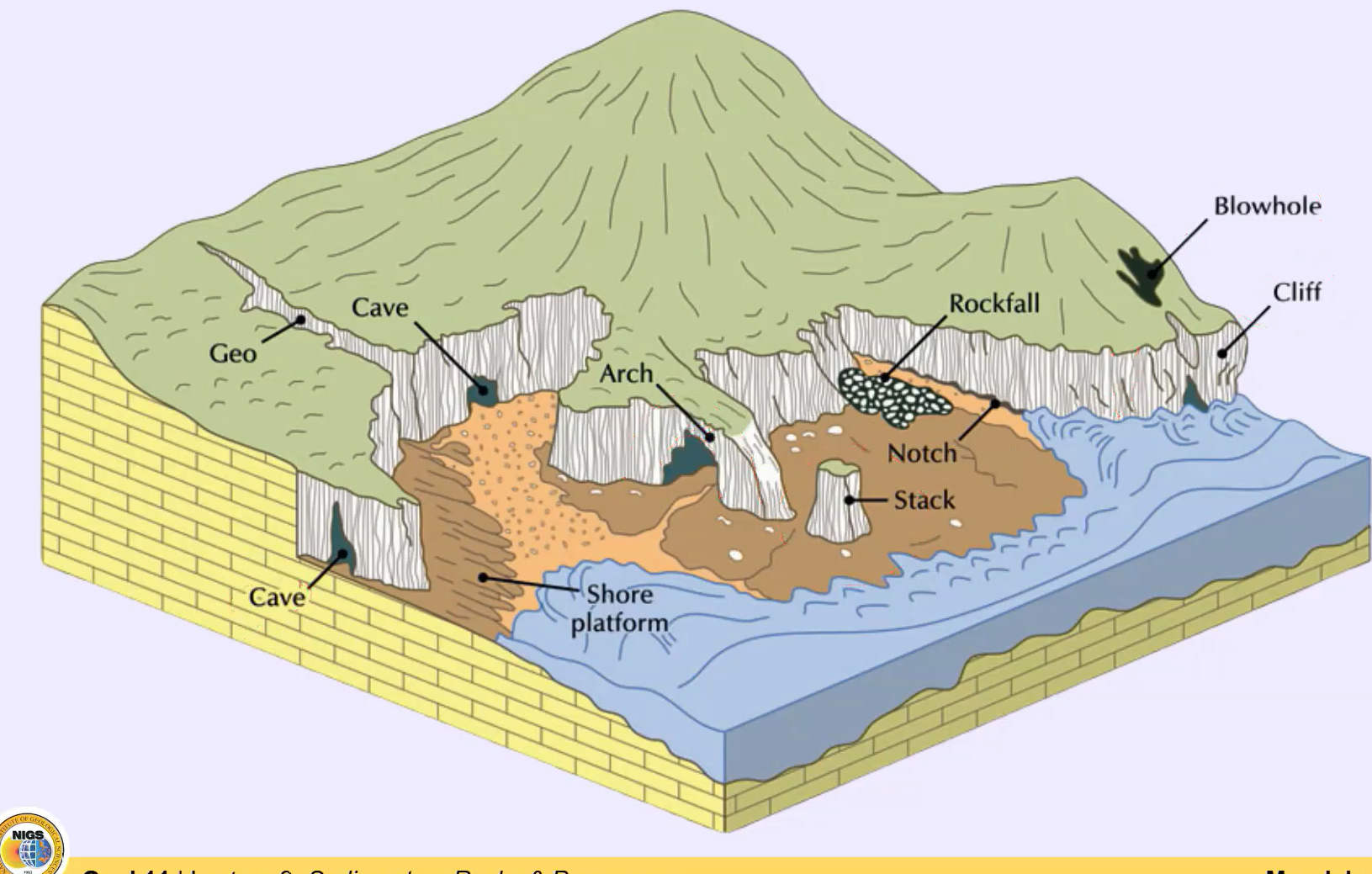
Biological Activities
interaction of organisms with rocks and sediments
Root Wedging - roots of plants tend to erode or weather rocks
Bioturbation (Animal Activities) - animals tend to burrow or disturb the sediments
Pholas dactylus (clams) - tend to burrow in rocks
Chemical Weathering
Dominant in wet and hot environments (humid and tropical environments)
Decomposition - breakdown of rock materials that involves changes in chemical composition
Chemical weathering attacks less stable minerals by leeching or alteration to more stable minerals
Incomplete in steep slopes; complete in gentler slopes
Dissolution
occurs when minerals are wholly or partly dissolved
breakdown of minerals into ions
dominant process in limestones and evaporites
Example: Halite reacting with water and it dissolves to sodium ions and chlorine ions
Carbonation
carbonic acid reacts with calcite to produce Ca²+ and HCO³-
Example: Calcite (calcium carbonate) reacts with aqueous solution (carbonic acid) —> calcium ion and bicarbonate ion
They are responsible for karst environment
Pinnacle karst - towering structures made of limestone that has been dissolved
Sinkholes - when limestones that are dissolved and the overlying layer is an unconsolidated layer
Ion Exchange
occurs when ions are directly exchanged between a mineral and a solution
Example: Potassium Feldspar (s) + Water with lots of dissolved hydrogen ions —> clay minerals and ions
Hydrolysis
chemical reaction between mineral and water in which dissolved [H+] ions and/or [OH-] are added to form one or more new minerals, typically silicates to hydroxides/clay minerals
Commonly results to clay minerals
Example: Potassium Feldspar + ions + water —> Kaolinite (clay mineral) + Orthosilicic acid + ions
Hydration / Dehydration
involves addition of water to a crystal structure during reaction between a mineral and an aqueous solution, converting into another mineral (reverse of this is Dehydration)
Addition of water molecule(s) in mineral structures. See wetting and drying
Examples:
Anhydrite + H2O = Gypsum
Hematite + H2O = Goethite and Limonite
Oxidation
chemical reaction in which one or more electrons are transferred from a cation to an anion, increasing the valence of the cation
Alteration of minerals by the exchange of electrons with other elements or compounds
Oxidation acts with hydrolysis to decompose ferromagnesian minerals (i.e. olivine, pyroxene, amphibole, biotite) to form hematite and limonite
Reduction - involves the gain of electron
Example:
Olivine —> Hematite
Rhodonite (pink, manganese-bearing silicate Mn²+) —> Manganite (Mn³+) + Orthosilicic acid
Laterite soil - reddish soil from the weathering of ultramafic rock
Bedrock (ultramafic)
Saprolite (reddish, nickel, Zone of accumulation)
Limonite (yellowish, fe and al, Zone of Eluviation)
Ferricrete
Organic-Decomposition
biological activity causing decomposition
Chelation - highly soluble organic molecules bind with metallic elements that remove them from the mineral
Example: Lichens also have significant impact in the chemical weathering of rocks by the excretion of various organic acids, particularly oxalic acid, which can effectively dissolve minerals and chelate metallic cations.
Goldich Stability Series - method of predicting relative stability or weathering potential of various minerals on the surface
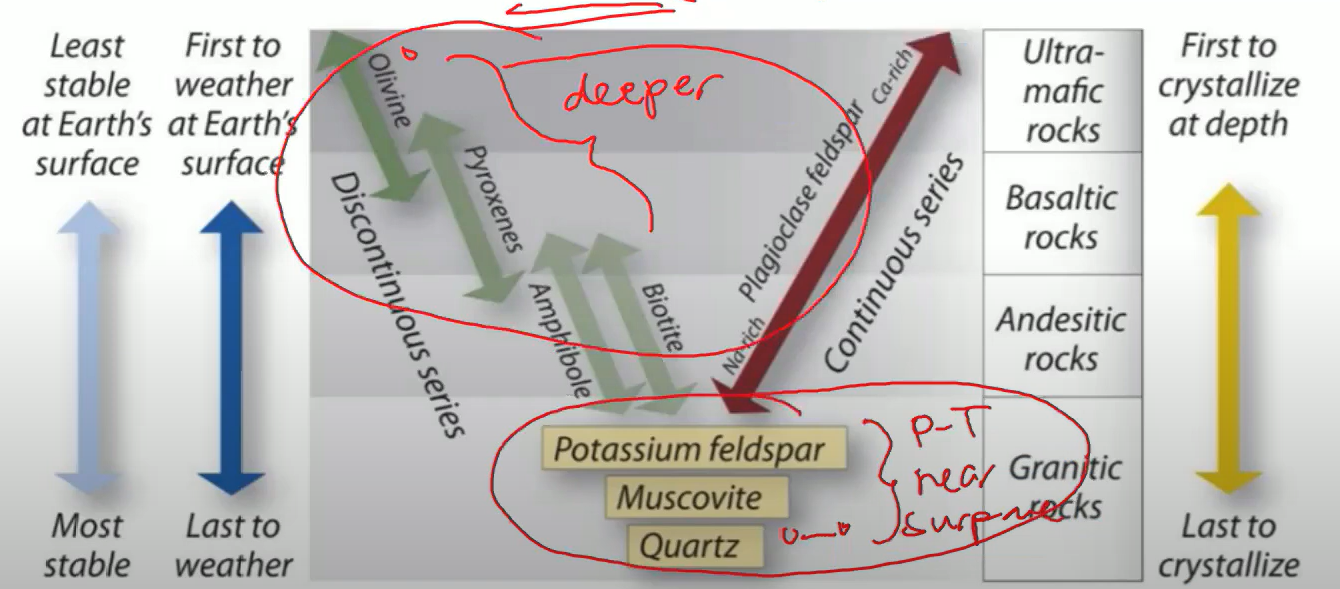
Dunites - rocks made of >90% olivine
Soil
a product of weathering
unconsolidated surficial deposits produced by weathering processes and capable of supporting rooted plants
composed of regolith, humus, water, and air:
Regolith - layer of sediments derived from the weathering of bedrock
Humus - organic matter
the formation of soil, given time, produces a soil profile (distinct horizons)
Factors controlling soil formation:
Sediment source - source rock composition determines how effective physical and chemical weathering processes
Climate
Precipitation - governs the extent of hydrolysis, hydration, and dissolution
Temperature Fluctuations - fluctuations determine importance of ice-wedging and insolation
Topographic Relief - controls the exposure of minerals to weathering agents
No soil development because of very steep slope
Transported soil developed on unconsolidated stream deposits
Thinner soil on steep slope because of erosion
Residual soil is developed on bedrock
Thicker soil develops on flat terrain
Erosion
Action of surface processes that wear away and transport rock particles and dissolved ions from the source
Agents:
Gravity
Wind
Water
Ice
Biological Activity
Transportation
Involves the mobilization and moving along of sediments
The relocation of weathering products from its source to its depositional site, via agents of transport
Erosion and Transportation
Agents:
Gravity
Mass Wasting - downslope movement of rock particles driven by gravity
Water
Traction - large sediments that roll and slide along the streambed (gravel)
Saltation - small sediments that bounce along the streambed (sand)
Suspension - fine sediments suspended by turbulence (silt)
Solution - dissolved minerals and ions in the water (clay)
Hjulström Curve
dictates how a particle size will behave at a certain river velocity
Water
Stream Capacity - measure of the total sediment a stream can carry
Stream Competence - maximum size of particles a stream can transport
Wind (Aeolian)
Traction - fine sediments suspended by turbulence
Saltation - small sediments that bounce along the bottom
Suspension - fine sediments suspended by turbulence
Ice
Glacial Sediments (Till) - derived by plucking and abrasion along the rock-glacier interface or by deposition of mass wasting and superglacial streams
Glaciers may carry sediments as an internal load or as surface load
Sediments
unconsolidated earth materials that are produced by weathering
can be small grains of rocks, minerals, plant-, and animal-remain
Texture
Refers to the size, shape, and arrangement of constituent particles and the void spaces in between
used in classification and interpretation
Includes:
Grain size
Sorting
arrangement or packing of grains with respect to each other
Roundness
Angularity
Transport Distance is inversely proportional with grain size, energy, angularity
Transport Distance is directly proportional to roundness and sorting
Deposition
When transportation agents can no longer carry the sediments, the sediments get deposited
The conditions of the depositional site environments contributes to the overall properties of sed rocks
Diagenesis
Refers to physical, chemical, and biological processes which collectively result in:
transformation of sediments into sedimentary rock (lithification); and
modification of the texture and mineralogy of the rock

Compaction
As sediment accumulates, the weight of overlying material compresses the deeper sediments
Cementation
Dissolved ions in groundwater may precipitate within pore spaces between sediment grains, forming cement
New minerals form among the spaces between the sediment grains which glue (cement) them together
Other diagenetic processes:
Recrystallization - unstable minerals undergo changes in their crystal structures to attain equilibrium (e.g. aragonite to calcite)
Replacement - new minerals are formed by altering the composition of existing minerals, or completely fill voids left by dissolution
Dissolution - unstable minerals are broken down into ions, which are leached away by pore fluids
Bioturbation - the disturbance of sediments or rocks by burrowing organisms
Sedimentary Rocks
Composition
may be made up of:
Detrital (siliciclastic rock)
Rock fragments
Quartz grains
Feldspar grains
Clay
Quartz Sandstone - quartz creating sandstone
Arkosic Sandstone - feldspar creating sandstone
Biochemical grains, and other common minerals
Gypsum
Calcite spar (crystals)
Dolomite
Halite
Ooids
Limonite
Hematite
Chert
Grain Size
For sedimentary rocks that are composed of clasts (detrital or biochemical rock and mineral fragments), the Udden-Wentworth scale is used to describe grain size.
Gravel (> 2mm)
Sand (1/16-2 mm)
Silt (1/256 - 1/16 mm)
Clay (<1/256 mm)
For sedimentary rocks made up of interlocking crystals instead of grains, the size maybe described as such:
Microcrystalline - crystals NOT visible under 10x hand lens
Macrocrystalline - crystals are visible under 10x hand lens
Roundness and Sphericity
The shape of grains in sedimentary rocks may be described based:
Sphericity - how close a grain’s shape is to a sphere
Roundness - the absence of angular corners in a grain; opposite of angularity
Sorting
The sorting of grains refer to how uniform the grain sizes are in a sediment sample
Sedimentary Structures
Bedding - one unit
Very thickly bedded if >100 cm
Thinly bedded if 3-10 cm
Laminae <1 cm
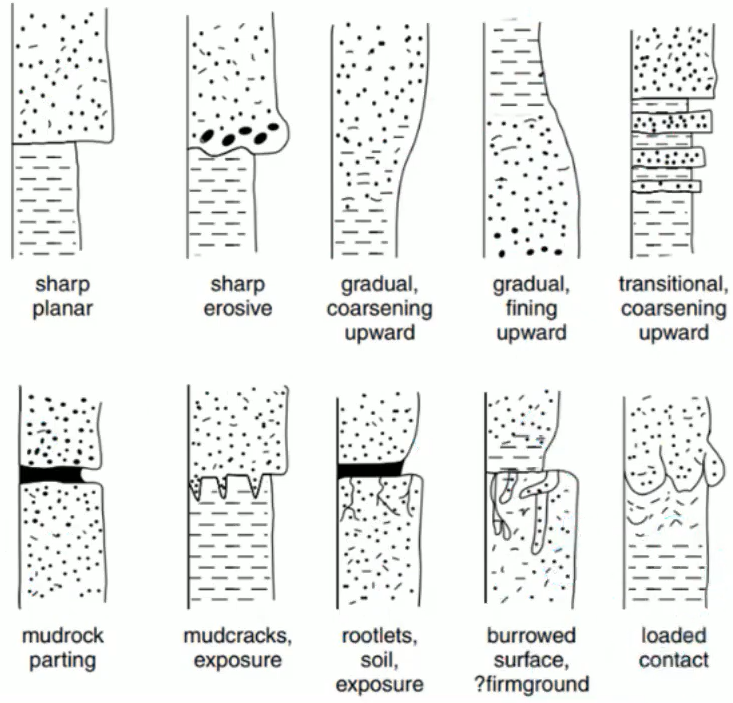
Cross-bedding
Mud cracks
Flute marks/casts
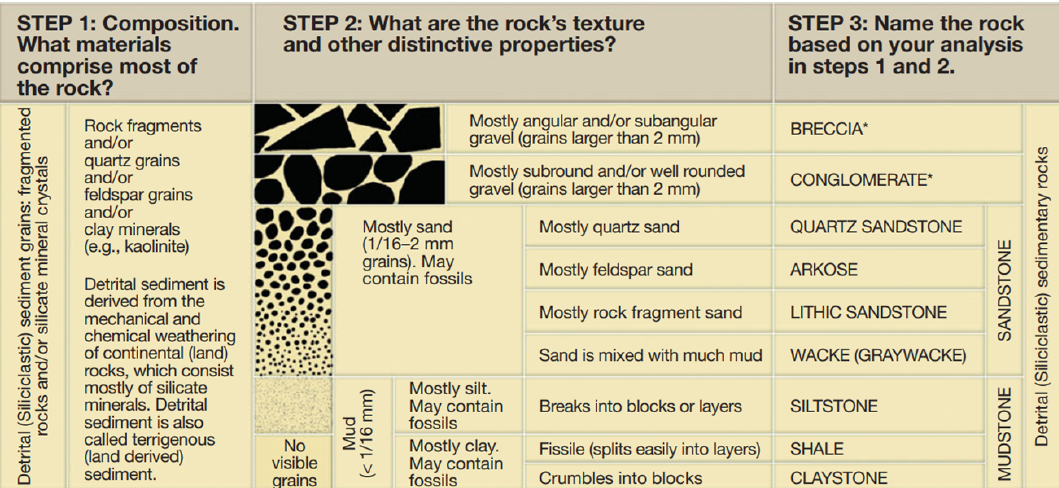
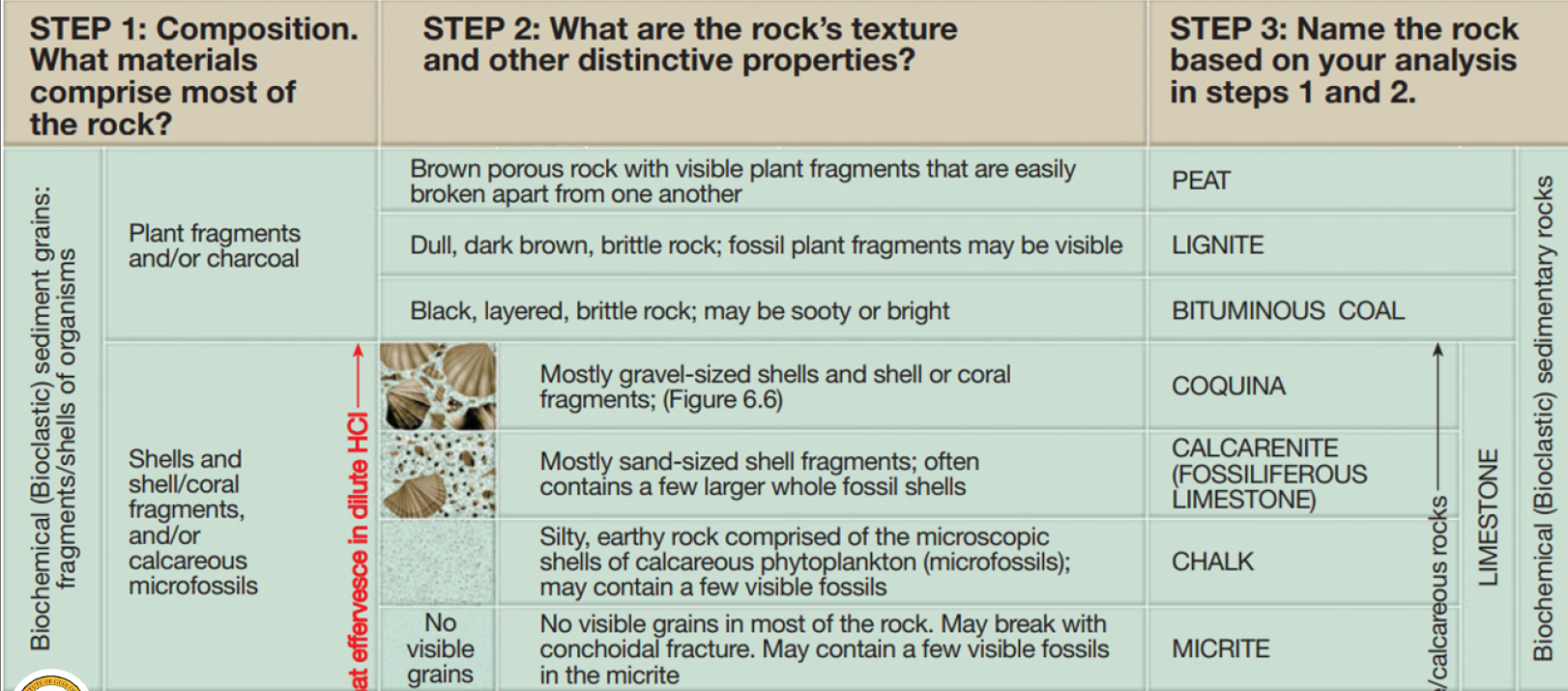
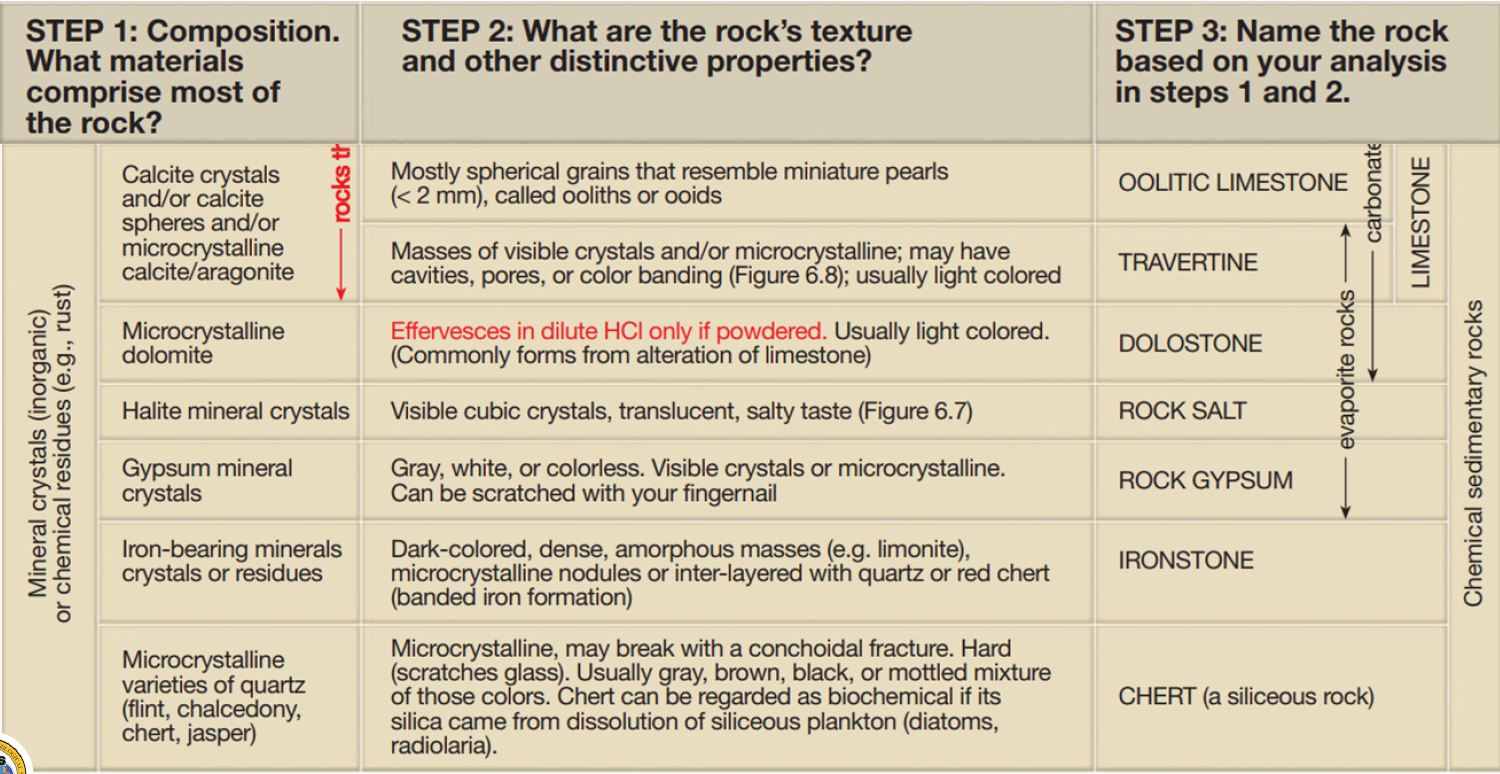
Importance of Sedimentary Rocks
Sedimentary rocks serve as hosts biologic record
Solnhofen - limestone where archaeopteryx are found
Birds = Avian dinosaurs
Gshelia species - oldest fossil in the Philippines and is composed of rugose coral (extinct)
Scleractinid corals - living corals
Sedimentary rocks serve as hosts for many mineral and energy resources
If permeable (like sandstone) , they can host oil and gas deposits
Sedimentary rocks serve as record of the Earth’s geological history